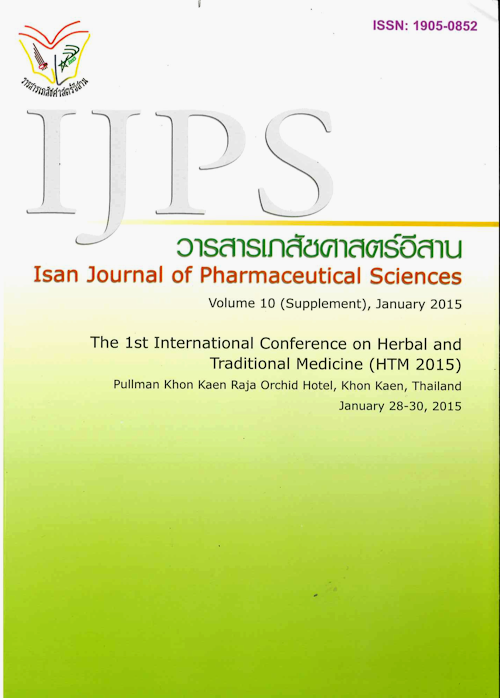Validation of Rutin Analysis in Cassava (Manihot esculenta) Leaves Using TLC-densitometer
Main Article Content
Abstract
Introduction: Cassava leaf is the lesser used part of cassava compared to the root, which
is a well known source of tapioca fl our. Cassava leaves contain several compounds with health
benefi ts, especially a fl avonoid called rutin. The aim of this study was to develop and validate method
for quantitative analysis of rutin in cassava leaf extract. Methods: All cassava leaves were extracted
with 80% methanol and applied semi-automatically in TLC aluminum sheets, precoated with 0.2 mm
thick layer of silica gel 60 F-254. The mobile phases were ethyl acetate-acetone – water [40:50:10]
and ethyl acetate – formic acid- water [60:10:10]. The extracts were analyzed for rutin content using
TLC densitometry. Results: The solvent system gave a compact spot for rutin with Rf value of 0.47.
Linear regression analysis data for the calibration curve of rutin showed good linear relationship with
r2 of 0.999 in the concentration range from 200 – 1000 ng/spot. The method was validated for interday
and intraday precision (overall % RSD < 6.91 %) and accuracy (% recovery = 97.69 -99.96 %). The
limit of detection and quantifi cation were 20 ng/spot and 100 ng/spot, respectively. The developed
method was applied to determine rutin contents in cassava leaf extract from Kasetsart 50 cultivar and
the contents was 12.30±0.61% dry weight. Conclusions: The developed TLC-densitometric methods
provided a good accuracy and selectivity for the quantitative determination of rutin in cassava leaves.
The rutin content analyzed by this method is effective and reliable.
Article Details
In the case that some parts are used by others The author must Confirm that obtaining permission to use some of the original authors. And must attach evidence That the permission has been included
References
Adewusi SRA, Bradbury JH. Carotenoids in cassava: Comparison of open-column and HPLC methods of analysis. J Sci Food. 1993; 62(4): 375-83.
Afshar D, Delazar A. Rutin from Ruta graveolens L. DARU Journal of Pharmaceutical Sciences. 1994; 4(1-2): 1-12.
Blagbrough IS, Bayoumi SAL, Rowan MG, Beeching JR. Cassava: An appraisal of its phytochemistry and its biotechnological prospects. Phytochemistry. 2010; 71(17–18): 1940-51.
Bodart P, Penelle J, Angenot L, Noirfalise A. Direct Quantitative Analysis of Linamarin in Cassava by High-Performance Thin Layer Chromatography. J Planar Chromat. 1998; 11(January/February): 38-42.
Communities CotE, editor Validation of Analytical Procedures. Proceedings of the Interna-tional Conference on Harmonization (ICH); 1996; Geneva, Switzerland. Eggum RO. The protein quality of cassava leaves. British Journal of Nutrition. 1970; 24: 761-8.
Galand N, Pothier J, Viel C. Plant drug analysis by planar chromatography. J Chromat Sci. 2002; 40(10): 585-97.
Gupta N, Sharma SK, Rana JC, Chauhan RS. Expression of flavonoid biosynthesis genes vis-à-vis rutin content variation in different growth stages of Fagopyrum species. J Plant Physiol. 2011; 168(17): 2117-23.
Ihme N, Kiesewetter H, Jung F, Hoffmann KH, Birk A, Müller A, et al. Leg oedema protection from a buckwheat herb tea in patients with chronic venous insuffi ciency: A single-centre, randomised, double-blind, placebo controlled clinical trial. Eur J Clin Pharmacol. 1996; 50(6): 443-7.
Nguyen TLT, Gheewala SH, Garivait S. Energy balance and GHG-abatement cost of cassava utilization for fuel ethanol in Thailand. Energy Policy. 2007; 35(9): 4585-96.
Prawat H, Mahidol C, Ruchirawat S, Prawat U, Tuntiwachwuttikul P, Tooptakong U, et al. Cyanogenic and non-cyanogenic glycosides from Manihot esculenta. Phytochemistry. 1995; 40(4): 1167-73.
Suzuki T, Honda Y, Mukasa Y. Effects of UV-B radiation, cold and desiccation stress on rutin concentration and rutin glucosidase activity in tartary buckwheat (Fagopyrum tataricum) leaves. Plant Science. 2005; 168(5):1303-7.


